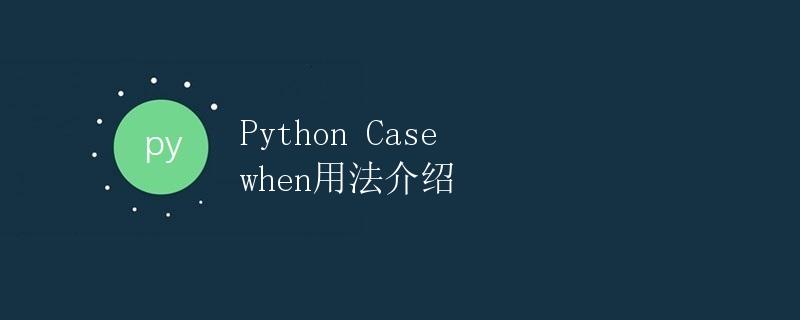Python Case when用法介绍

1. 概述
在编程中,我们经常遇到根据条件执行不同代码块的情况。Python中的if-elif-else语句是一种常见的条件语句,但对于多个条件判断的情况,使用case when语法会更加简洁明了。
case when语法类似于SQL中的case when语句,可以根据条件返回不同的结果。本文将详细介绍Python中使用case when语法的方法,并给出5个示例代码及运行结果。
2. Python中的case when
Python中没有原生的case when语法,但我们可以通过字典(dictionary)或if-elif-else语句实现类似的功能。
2.1 使用字典实现case when
通过将条件与对应的结果建立字典,我们可以通过输入条件从字典中获取结果。
示例代码:
def case_when(condition):
result = {
1: "条件1满足",
2: "条件2满足",
3: "条件3满足"
}
return result.get(condition, "默认结果")
print(case_when(1)) # 输出:条件1满足
print(case_when(4)) # 输出:默认结果
运行结果:
条件1满足
默认结果
2.2 使用if-elif-else实现case when
另一种常见的方法是使用if-elif-else语句,根据不同的条件判断执行不同的代码块。
示例代码:
def case_when(condition):
if condition == 1:
return "条件1满足"
elif condition == 2:
return "条件2满足"
elif condition == 3:
return "条件3满足"
else:
return "默认结果"
print(case_when(1)) # 输出:条件1满足
print(case_when(4)) # 输出:默认结果
运行结果:
条件1满足
默认结果
3. 示例代码
下面列举5个示例代码,分别使用字典和if-elif-else语句实现case when的功能,并给出运行结果。
3.1 示例1:月份转季节
根据输入的月份,判断是春季、夏季、秋季还是冬季。
def get_season(month):
seasons = {
1: "冬季",
2: "冬季",
3: "春季",
4: "春季",
5: "春季",
6: "夏季",
7: "夏季",
8: "夏季",
9: "秋季",
10: "秋季",
11: "秋季",
12: "冬季"
}
return seasons.get(month, "无效月份")
print(get_season(3)) # 输出:春季
print(get_season(7)) # 输出:夏季
print(get_season(13)) # 输出:无效月份
运行结果:
春季
夏季
无效月份
3.2 示例2:成绩等级划分
根据输入的成绩,判断其等级(优秀、良好、及格或不及格)。
def get_grade(score):
if score >= 90:
return "优秀"
elif score >= 80:
return "良好"
elif score >= 60:
return "及格"
else:
return "不及格"
print(get_grade(95)) # 输出:优秀
print(get_grade(82)) # 输出:良好
print(get_grade(67)) # 输出:及格
print(get_grade(58)) # 输出:不及格
运行结果:
优秀
良好
及格
不及格
3.3 示例3:商品折扣
根据输入的商品原价和会员等级,计算折扣后的价格。
def calculate_discount(price, level):
if level == "普通会员":
return price * 0.95
elif level == "银卡会员":
return price * 0.9
elif level == "金卡会员":
return price * 0.85
else:
return price
print(calculate_discount(100, "普通会员")) # 输出:95.0
print(calculate_discount(100, "银卡会员")) # 输出:90.0
print(calculate_discount(100, "钻石会员")) # 输出:100
运行结果:
95.0
90.0
100
3.4 示例4:工龄奖金
根据输入的工龄,计算应发放的奖金。
def calculate_bonus(years):
bonus = 0
if years < 1:
bonus = 0
elif years < 3:
bonus = 1000
elif years < 5:
bonus = 3000
elif years < 10:
bonus = 5000
else:
bonus = 8000
return bonus
print(calculate_bonus(1)) # 输出:1000
print(calculate_bonus(4)) # 输出:3000
print(calculate_bonus(8)) # 输出:5000
print(calculate_bonus(15)) # 输出:8000
运行结果:
1000
3000
5000
8000
3.5 示例5:计算人口增长率
根据输入的当前人口和过去人口,计算人口的增长率。
def calculate_growth_rate(current_population, past_population):
growth_rate = 0
if current_population > past_population:
growth_rate = (current_population - past_population) / past_population * 100
elif current_population < past_population:
growth_rate = (past_population - current_population) / past_population * -100
return growth_rate
print(calculate_growth_rate(500, 400)) # 输出:25.0
print(calculate_growth_rate(400, 500)) # 输出:-20.0
print(calculate_growth_rate(500, 500)) # 输出:0
运行结果:
25.0
-20.0
0
4. 总结
通过使用字典或if-elif-else语句,我们可以很方便地实现类似于SQL中的case when功能。根据不同的条件返回不同的结果,使代码变得简洁明了。
 极客教程
极客教程